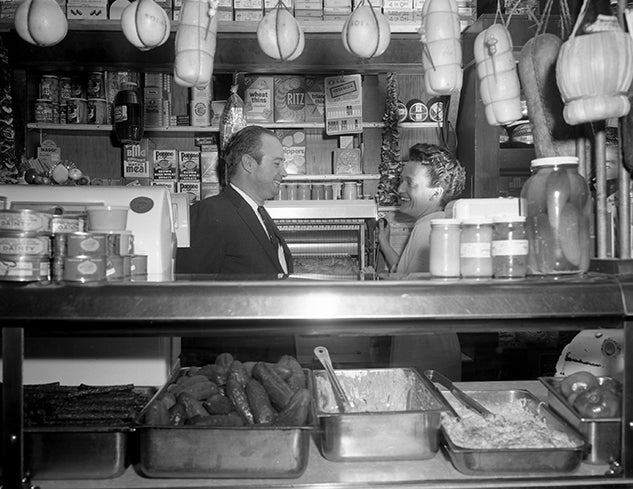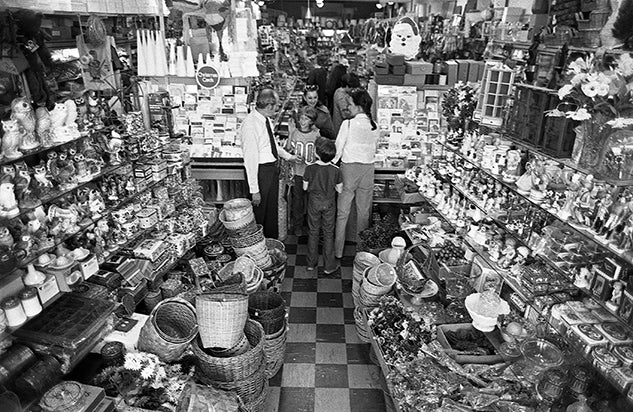Rice’s Village
Reuben sandwiches. Green beer. Vinyl. Dresses and suits. For generations of Rice students and faculty, a walk to the nearby Village offered access to all the necessities — and more — of college life.

Spring 2018
By Deborah Lynn Blumberg
Illustration by Amy C. Evans
The Wednesday after Thanksgiving, hundreds of Houstonians gathered alongside a cappella groups outfitted in Santa hats in front of the Rice Village Christmas tree. They’d come for the Village’s first annual sing-off, emceed by Tony Dovolani of “Dancing With the Stars.”
Songs, from “Silver Bells” to “Santa Claus Is Coming to Town,” prompted Rice students and community members alike to dance as fake snow fell from the sky. After the winner was announced and the tree lit, students, couples and families dispersed into the Village. Some made their way up Morningside Drive to Helen Greek Food and Wine, named one of the “21 Best New Restaurants in America” by Eater, while others wandered down the block for loaded fries and craft beer at the newly opened Hopdoddy Burger Bar.
Along the way, pedestrians paying attention might have marveled at a new blue aluminum owl sculpture on Kelvin Drive or outdoor seating areas that hadn’t been there months before. They may have doubled back to examine stores’ new, modern fixtures, and looked out for signs about the upcoming openings of the popular New York-based Shake Shack burger joint or SusieCakes, a tasty California-based bakery.

The Village was abuzz with activity, and that’s just what organizers had hoped for. The sing-off was one of dozens of new initiatives, programs and big changes dreamed up by Trademark Property Co., the property management group that now looks after the real estate of Rice Management Company (RMC), the steward and investment office for Rice University’s nearly $6 billion endowment and the Village’s largest property owner.
For retailers, “we want the best of the best,” said Tommy Miller, managing director for Trademark, who, with his team, has been tasked with reimagining the Village to create a more modern shopping and dining experience for visitors.
Since the 1990s, the Village, long known for its eclectic mix of shops and sometimes quirky shopkeepers, assumed more of a shopping mall feel. Under the watch of the prior developer, Weingarten Realty Investors, big-name brand stores like the Gap and Banana Republic moved in, architecture became more uniform, and wear and tear set in.
Now, plans are underway to revitalize the area, while staying true to its roots. Ceci Mesta Arreola ’09, real estate manager for RMC, envisions Rice Village becoming Houston’s go-to shopping destination. Boston has its Newbury Street; New York City has Madison Avenue. “Our goal is pretty lofty,” Arreola said. “Rice Village should be, and it needs to be, one of the best urban shopping districts in the country.”
A Multimillion-Dollar Project
In 2014, RMC tapped Trademark to help run its holdings in the Village, the majority of which are located between Kirby and Morningside drives and University and Times boulevards.
Rice had just purchased the brick-faced Village Arcade retail center that stretched two blocks on University Boulevard, giving RMC more control over the properties that it ground leased to Weingarten in the 1990s and setting off a multimillion-dollar renovation project. The goal was to refresh the area while helping grow Rice’s endowment, which provides nearly 40 percent of the university’s annual operating budget and helps support student scholarships. Already, new tenants have helped bump up the RMC’s rental income, Arreola said.

“First and foremost, we’re the stewards of the endowment,” said Arreola. “We’re working for student scholarship. Not only for today’s students, but for students for years to come. The Village also has this nostalgic element to it that we have to help preserve.”
With its lack of an anchor store and location nestled among homes near the university, the Village is unique. It’s Houston’s only walkable grid shopping area. It has appeared in films — parts of the 1994 movie “The Chase” were filmed there — and has created countless memories since shops like Rice Boulevard Food Market opened in the late 1930s.
Special Memories


Every alumnus has their own unique story or memory about the Village. For Arreola, it’s celebrating classmates’ birthdays at Mi Luna and sipping green beers at Brian O’Neill’s [now The Gorgeous Gael] on St. Patrick’s Day.
For Pedro Garcia, chef and owner of El Meson Restaurant on University Boulevard, it’s Reuben sandwiches from the former Alfred’s Deli on Rice, or the typeball he bought at Dromgoole’s Fine Writing Instruments — in the Village since 1961 — to whip up El Meson menus on his electric typewriter.
Garcia, a New York native who was named Restaurateur of the Year in 2016 by the Greater Houston Restaurant Association, has been serving favorites like paella and pulled pork at El Meson for the last 36 years. He has watched generations pass through his doors. Recently, as president of the Rice Village Alliance, Garcia helped brainstorm programming ideas akin to the sing-off: fashion shows and food festivals, events that will draw crowds. “The Village is moving back to more individuality, to more eclectic shops,” Garcia said.


Other alumni reminisce over nights at The Ginger Man, the Village’s first bar, which now includes locations across Texas and up the East Coast. Some recall squeamishly sampling chocolate-covered ants and grasshoppers at Kahn’s Deli. The Poor Man’s Country Club, a beer joint; Rat Records; and Iowa, a seller of Iowa folk art, were also favorites. In the 1960s, haircuts for Rice students went for $1.75 at the Times Barber Shop.
David Gibbs ’70, who owns several properties in the Village, has been frequenting Village shops for more than 50 years. In the 1980s, he acquired two properties along with fellow alumni Guy Jackson ’71 and Chuck Reid ’47 and Rice architecture professor Will Cannady that the foursome developed into Village Square at Rice Boulevard and Morningside Drive. Gibbs has fond memories of browsing ski apparel at J. Rich Sports in the 1970s and sipping smoothies at the Cultured Cow in the 1980s.

When Rebecca Greene Udden ’73, executive artistic director of the Main Street Theater, was a Rice student, she regularly popped down to the Village to buy props and costume accessories at Variety Fair 5 & 10 for her Baker Shakespeare Theatre productions and dined with friends at Dairy Queen on Sunday nights.
“Store owners in the Village are like a family,” said Udden, who recently helped to oversee a major renovation at Main Street Theater. “It’s a community here.”
A Major Face-Lift
At the top of management’s to-do list: refresh store facades, add more outdoor seating areas, and improve landscaping and parking.

The installation of more than 300 parking meters has been Trademark’s most controversial change thus far, but one management says was sorely needed. Free parking spots in front of stores were exacerbating traffic, Arreola said, as shoppers waiting for a spot circled the area. Pedestrians trying to cross at poorly marked crosswalks were at risk.
“We had a study done that showed we have enough parking, it just wasn’t being properly allocated,” she said. Now, shoppers who want to park in front of stores pay $1 per hour on weekdays and $2 per hour on weekends at a meter. In one of the Village’s two garages, parking is free for the first two hours and maxes out at $5 a day.
Trademark has revitalized crosswalks and also carved out a handful of parking spots near Hopdoddy to create Morningside Plaza, an outdoor gravel-covered area with seating, free Wi-Fi and games like Cornhole. Plans are in the works to create similar open spaces around other properties.
New tenants continue to roll in, though long-term leases — the Gap’s, for example, goes through 2023 — will keep certain stores around for a while. Similar retailers, like Chico’s and Soma, have been relocated and grouped together. This approach “makes merchandising more rational,” Arreola said.

On Amherst Street between Kirby and Kelvin, renovations have included deconstructing the singular brick facade to give stores their own unique look with a variety of textures and materials. They’ve added more trees, grass and seating and installed additional public art. An inviting high-end Starbucks with leather chairs that serves alcohol reopened on Amherst in December. Shake Shack opened in February and Rice Athletics — selling Rice apparel like T-shirts, hats and sweatshirts — opened in February.
In other areas, columns and ceilings have been raised along sidewalks, making them more walkable and spacious. “We’ve been peeling things away,” said Arreola.
Keeping It Quirky
On Rice Boulevard at the British Isles, longtime store owner Guy Streatfeild is pleased with recent changes, even the parking meters. He arrived in the Village in the 1990s to revive what had formerly been the British Market.
“The Village is always changing,” Streatfeild said from behind the counter of his specialty shop stocked with tea sets and other British-inspired gifts. He has noticed more foot traffic since new residential buildings were constructed in the last few years, including the Hanover Rice Village apartments on Dunstan Road in 2014. Streatfeild’s current Village favorites include coffee and scones at the Mercantile on Morningside, and the Croissant-Brioche bakery and Hungry’s located on Rice Boulevard.


On Kirby at the Chloe DAO boutique, owner Chloe Dao, the winner of “Project Runway” season two, is among merchants helping bring to life new, innovative outdoor events in the Village. When Dao moved back to her native Houston from New York almost 18 years ago, she knew she wanted to set up shop in the Village.
“The Village has the closest vibe to New York,” she said. “It’s really eclectic, and it’s one of few walkable shopping centers. It definitely needed a face-lift, and I love the makeover.”
Most recently, Dao helped plan an outdoor fashion show. Other event ideas include a block party and a food and wine festival. El Meson’s Garcia is convinced that experiences like these will help businesses compete.
“People are shopping online,” he said, “but they’ll come out for unique experiences and specialty stores. That’s going to be the saving grace of the brick-and-mortar industry.”
Arreola sees it all as part of the Village experience. “We’re making it a place where people want to come and stay,” she said. “We’re focused on making this a fabulous place for everyone at the university and everyone in the community to enjoy.”
